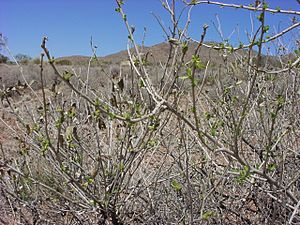Flourensia cernua facts for kids
Quick facts for kids Flourensia cernua |
|
|---|---|
 |
|
| Conservation status | |
| Scientific classification | |
| Kingdom: | |
| (unranked): | |
| (unranked): | |
| (unranked): | |
| Order: | |
| Family: | |
| Genus: |
Flourensia
|
| Species: |
F. cernua
|
| Binomial name | |
| Flourensia cernua |
|
| Synonyms | |
|
|
Flourensia cernua is a type of flowering plant in the aster family. People often call it American tarwort or tarbush in English. In Spanish, it has names like hojasé, hojasén, and hoja ancha.
This plant grows naturally in the Chihuahuan Desert of North America. You can find it in parts of the United States, like Arizona, New Mexico, and Texas. It also grows in Mexican states such as Sonora, Chihuahua, and Coahuila. Most plants in its group, Flourensia, are found in Latin America. Tarbush is one of only two species that reach into the United States.
Contents
What is Tarbush?
Tarbush is a shrub that usually grows about one meter (40 inches) tall. Some can even reach two meters (7 feet). It can grow straight up or spread out. It has many branches that start from the bottom.
Leaves and Flowers
The branches have thick, oval leaves that are about 2.5 cm (1 inch) long. Sometimes they can be up to 4 cm (1.5 inches). The edges of the leaves are smooth or slightly wavy.
The plant produces hanging flower heads. These heads have several small yellow disc florets. They do not have the larger, petal-like ray florets you might see on a sunflower. After flowering, it produces a hairy fruit called an achene. This fruit is about 1 cm (0.4 inches) long.
Most parts of the tarbush plant are very sticky and resinous. They have a smell like tar or hops. The plant also tastes bitter.
How Tarbush Grows
Tarbush is a deciduous plant in most places. This means it loses its leaves in winter. However, if there is enough moisture, it might keep its leaves.
The amount of moisture affects how the plant grows. If spring is dry, it might grow small, scale-like leaves first. Then, as more rain comes, it will grow larger leaves. The plant flowers in the fall. In dry years, it produces fewer flowers.
Roots and Water
Tarbush has a special root system. It has many shallow roots that spread out up to four meters (13 feet) wide. It also has a few very deep roots, going down up to five meters (16 feet). This helps the plant collect water from a large area. This is a great way for it to survive in its dry desert home.
Where Tarbush Lives
Tarbush grows in desert scrub and desert grassland areas. It has become more common in these places recently. This is partly because of overgrazing by animals. Overgrazing reduces the native grasses, like grama grasses.
Tarbush is a key plant that shows you are in the Chihuahuan Desert scrub. This type of desert covers about 70% of the Chihuahuan Desert. Here, tarbush often grows alongside creosotebush and viscid acacia.
Plant Neighbors
Other common plants found with tarbush include:
- Whitethorn acacia
- Catclaw acacia
- Honey mesquite
- Berlandier wolfberry
- Mariola
- Wright's beebrush
- Littleleaf sumac
- Broom snakeweed
- Winterfat
- Smooth-leaf sotol
Tarbush is part of many different plant communities. It is often the main shrub in areas that are mostly covered by grasses. It can grow scattered or in thick groups. It can even form areas where it is the only shrub, especially in clay and silt soils. It grows best in soils made from limestone, which is common in the Chihuahuan Desert. Tarbush plants are known to live for a long time.
Uses of Tarbush
Tarbush has been used for medicine. In Mexico, people make a tea from it. This tea is used to help with stomach problems like indigestion and diarrhea. It is also used for breathing issues. You can find the leaves and flower heads sold in farmers' markets in Mexico and the United States.
Tarbush and Animals
Scientists have studied tarbush as a possible extra food source for livestock like sheep. Since it is becoming more common in the Chihuahuan Desert, people are interested in its value as food for farm animals. It has a high protein content, similar to alfalfa.
However, tarbush also contains compounds that make it taste bitter and "peppery." This makes animals not want to eat it. Also, the flowers and fruits can be harmful to sheep, goats, and cattle. Animals usually avoid eating these parts of the plant. While the leaves can be eaten in small amounts for their nutrition, a diet made only of tarbush can be dangerous for animals.
Images for kids



